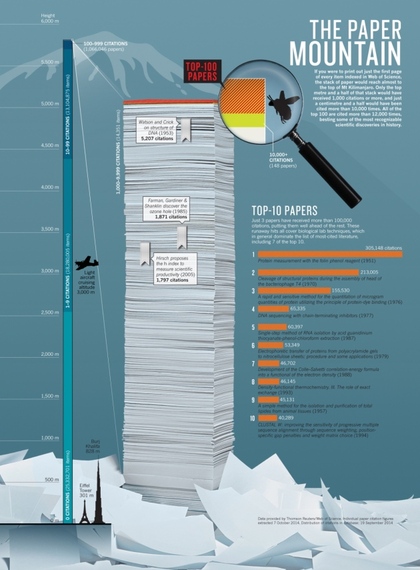For scientists and scholars toiling at their research and publishing their findings, the most immediate reward from the scientific community is a citation, when fellow researchers read their work and include it among the footnotes of a newly published paper. This acknowledgement -- being "cited" -- indicates that a paper has been judged by peers to be significant and useful. Citations, however, can be hard to come by. Many papers are cited perhaps once or twice, and many others not at all.
At the opposite end of the spectrum are the blockbusters -- publications that have amassed tens of thousands of citations.
The scientific journal Nature, using data from Thomson Reuters, has published an examination of this elite group: science's 100 most-cited papers. Anchoring the study is Thomson Reuters Web of Science, an online index that covers the contents of roughly 12,000 scientific and scholarly journals, along with conference proceedings, book chapters, and other sources. This store of data now numbers more than 58 million indexed items, stretching back to the year 1864. The Web of Science also tracks citations, recording where and when each item has been cited in a subsequent publication.
Drawing on this citation data, Nature provides an arresting representation of the body of scientific work and the rarified place occupied by the super-cited outliers. If the first pages of each Web of Science-indexed item could be magically placed in a stack, the tower would reach nearly to the top of Mount Kilimanjaro -- 5,895 meters, or some 19,000 feet. Publications representing almost half the stack from its lower reaches -- about 2,500 meters, and roughly 25 million papers -- have not been cited at all. Proceeding upward, 18 million reports have recorded between 1 and 9 citations, while 13 million have collected between 10 and 99. Only about 15,000 papers have been cited 1,000 or more times.
The top 100 reports, meanwhile -- papers attaining a threshold exceeding 12,000 citations -- would constitute a mere centimeter's width atop the stack.
As Nature observes, one might expect that the top 100 would prominently feature some of science's most celebrated advances and the stuff of Nobel prizes: determining the structure of DNA, attaining superconductivity without electrical resistance, discovering the ozone hole in Earth's atmosphere, and the like.
The reality, however, is that science's citation heavyweights predominantly describe methods and tools for carrying out research. Thousands of scientists make use of the methods and, each time they report their work in a published paper, duly credit the original authors with a citation. In the process, thanks to the methods described, the scientific advancements accumulate and build on one another.
The all-time citation champion, for example, is a 1951 report presenting a method for measuring protein in a solution. A comparatively unglamorous offering, perhaps, but very broadly useful; the paper holds the record, with more than 300,000 citations.
Citation blockbusters of more recent vintage, as Nature discusses, provide tools for analyzing DNA, for determining the atomic structure of proteins and other substances via crystallography, and for modeling the motions of electrons in a range of materials, to name just a few applications. In particular, recent years have seen the development of large comparative databases and statistical techniques designed to aid the analysis of huge amounts of data, from the subatomic world to the minute variations in the human genome.
The Nature article includes a listing of all 100 of the top papers, along with an interactive display that lets readers chart the annual trajectory of each paper's citations as recorded in the Web of Science, where these immensely useful papers and others to come, and their reverberating impact in scientific progress, will continue to be tracked.

